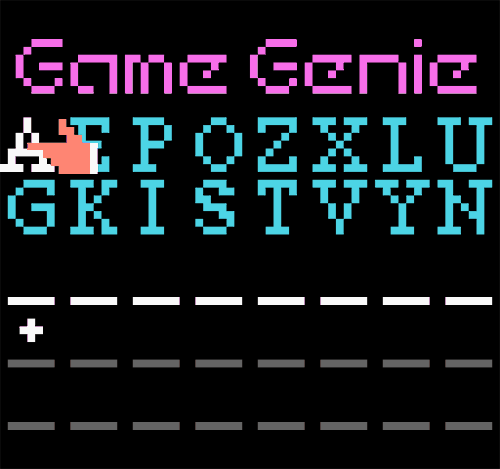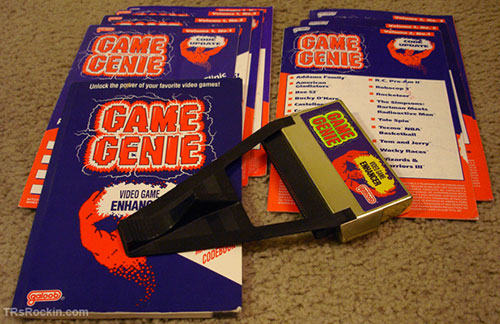The Game Genie Generation
For manchildren of a certain age, the Game Genie opened up a new world of opportunity for boring games—and had a profound effect on copyright law.
"We didn’t have a license to create Nintendo games so we found a way of bypassing Nintendo’s lock-out chip and released games that way. We had an idea of placing a switch on the cartridge to add extra lives, weapons and things like that. Then we made the mental leap of saying that if we could do this with our own games, then maybe we could build an interface for other people’s games too. It was a game that morphed into an industry."
— David Darling, one of the founders of Codemasters, the British gaming company that first created the Game Genie in the late 1980s, discussing how the device came to be. Darling, who produced dozens of games over the years—most notably the Fantastic Dizzy series—eventually licensed the idea to Galoob, a major American toy company that started selling the NES version of the device in mid-1990. They eventually turned the hacky device concept into a $140 million cottage industry. For creating the Game Genie and helping develop the British gaming industry, Darling and his brother Richard were made Commanders of the Order of the British Empire back in 2008. See, even the queen noticed!

Why the Game Genie mattered
For manchildren of a certain age, the Game Genie was an important bedrock of their cultural growth, playing a similar role for gamers that The Beastie Boys' Paul's Boutique did for vinyl-heads.
The reason? It suggested that that these things we experience didn't have to be used only one way. Mario didn't necessarily have to jump in one direction—in fact, he could jump backwards, live unlimited lives, and have all the firepower one could ever need. This was crazy talk, the stuff of fantasies!
In a lot of ways, the ability to type in codes to tinker with the way that a game worked was akin to being a grease monkey or HAM radio operator in an earlier generation. Once you figured out there were these codes that could change, and that the little booklet was only the starting point for what was possible, suddenly a ton of opportunities arose.
The fact that the Game Genie came along at this particular time, when the Nintendo Entertainment System and Sega Genesis libraries mostly consisted of relatively simple games, was part of the appeal. It was the best possible evidence that the technology around us, like words and art before, is brittle and malleable. That other people's creativity can be changed.
When HTML, PHP, and JavaScript became the lingua franca of the internet a decade later, a lot of those coders probably cut their coding-mindset teeth not on BASIC, but on Game Genie codes. The Game Genie even helped inspire a fairly strong glitch-gaming culture that persists to this day.
If you don't believe me, just look at the manyYouTubevideos out there highlighting the crazy crap this device can do to the original Super Mario Bros.—a game whose simplicity makes for easy, fun hacks.
If this idea only came around at the time of the Sony Playstation, just imagine what we would have missed out on. (Sorry, GameShark fans.)
Five of the Game Genie's many unusual quirks
- On the NES, the Game Genie gave an already quirky horizontal cartridge-loading mechanism a little extra trouble. The silicon on the device bent the console's pins, which eventually meant that if you used it too much, your console wouldn't work without it.
- The Game Boy version of the device was freaking huge, with a ton of extra plastic. And because the device stopped being made around the mid-1990s, that meant no newer versions came out, making it downright impractical to use with any Game Boy besides the original.
- The Super Nintendo version didn't work with games that had built-in performance-enhancing chips inside the cartridges, at least at first. Sucks if you're a Starfox fan.
- Unlike Nintendo, Sega backed the Game Genie, making Galoob an official licensee of the company. Sega, however, required the device not to be compatible with games that had built-in save functions, such as Shining Force.
- On the Sega Game Gear, if you typed in the code "DEAD," the screen would bounce. Because honestly, why not?

How the Game Genie set the stage for the internet's remix culture
Because the device allowed gamers to effectively change the code of the game, this meant that it was not the original product sold to consumers. And Nintendo didn't like that.
Galoob wanted to work with Nintendo and release the Game Genie as a licensee, but Nintendo being Nintendo, it was their rules of the road, or no road at all. Galoob, being a pretty sizable company outside of the video game space, wasn't really bothered by that, so they released the Game Genie anyway and gave it the kind of Saturday-morning advertising push they gave all their toys back then.
But this being Nintendo at the height of its success, Galoob soon found itself facing legal action over its product. For about a year, in fact, the company couldn't even sell the Game Genie in the U.S. It was contraband that was only available in Canada.
But like a quick-witted Micro Machines pitchman, Galoob ultimately got the last word in: The lawsuit proved not only a big mistake for Nintendo, but it ultimately made copyright more elastic than ever before. The reason can be found in the 1992 decision by the Ninth Circuit Court of Appeals.
In his ruling, Joseph Jerome Farris basically found that slight modifications of a derivative work were allowed, as long as the original form of copyright was kept intact.
"The Game Genie merely enhances the audiovisual displays (or underlying data bytes) that originate in Nintendo game cartridges," the legal decision states. "The altered displays do not incorporate a portion of a copyrighted work in some concrete or permanent form."
As you can imagine, this ruling was a pretty big deal, because it effectively allowed for non-destructive remixes of copyrighted items, making it easy for consumers to define their own experiences with the items they own. Nintendo not only lost, but lost big.
$15M
It's something of a great irony that Nintendo is a couple months away from releasing the hotly anticipated Wii U game Super Mario Maker, which in some ways takes the great joy of modifying a game that everyone knows in unexpected ways.
Galoob and Codemasters may have been trying to give us infinite lives, but they instead gave us an idea of what it was like to play God with a game, to change its basic shape and how we interact with its basic elements. It was a thrill back then, and it's a thrill now.
If only Nintendo had figured this out a quarter-century ago when they could have used this to make their games even better.
:format(jpeg)/2018/04/wrusyllecf1haehukurx--1-.gif)
/2018/04/wrusyllecf1haehukurx--1-.gif)

/uploads/ernie_crop.jpg)